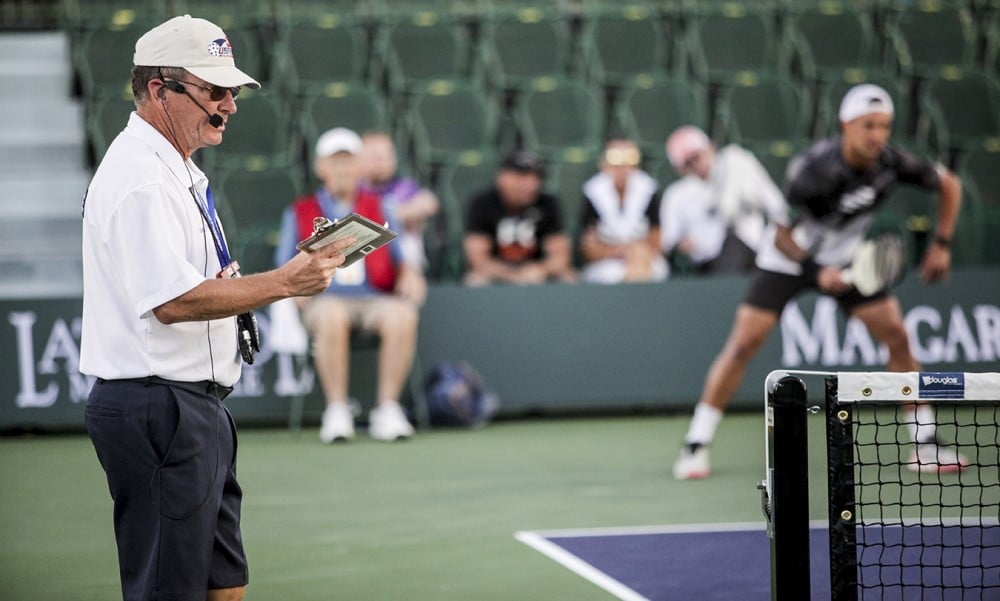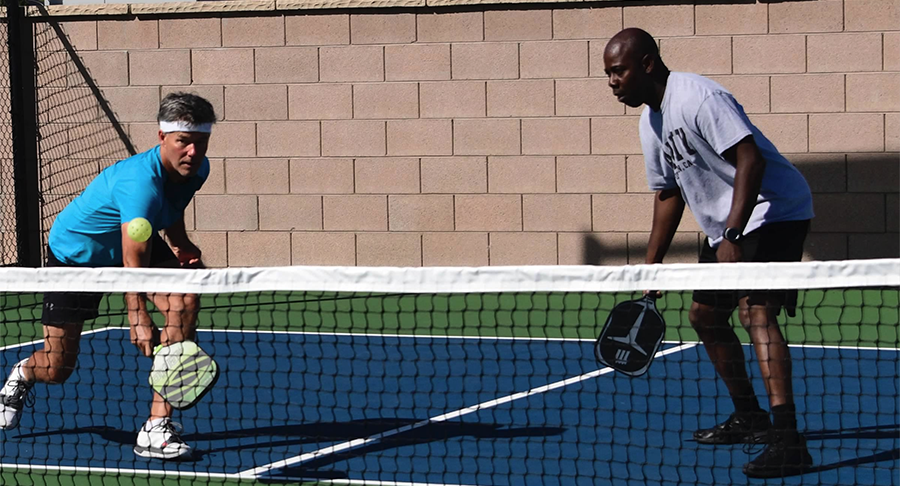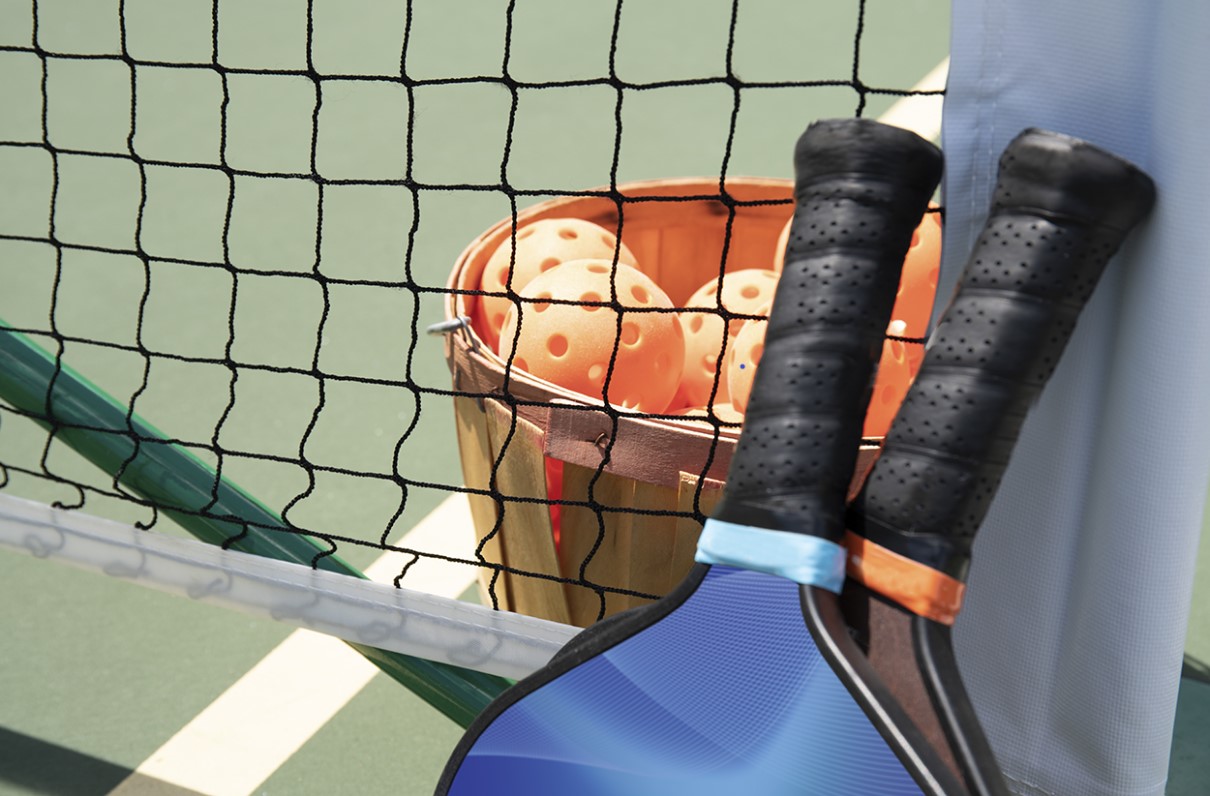(This article by Kathie Rowell originally appeared in the September 2020 issue of Military Officer, a magazine available to all MOAA Premium and Life members. Learn more about the magazine here; learn more about joining MOAA here.)
Why is pickleball — a mishmash of tennis, table tennis, and badminton — the fastest-growing sport in America?
It’s addicting, say military retiree enthusiasts, who praise its fusion of competition and camaraderie.
“It really is fun. I guess that’s the bottom line of this thing,” said 66-year-old Cmdr. Mark Peifer, USN (Ret), who was introduced to pickleball two weeks after retiring in 2015. “It took me 10 minutes before I realized this is what I’m going to do in retirement.”
Within three weeks of first picking up a paddle, Peifer, a MOAA member who lives in southern California, was playing four times a week. Now he’s an official USA Pickleball Association (USAPA) Ambassador. As a certified referee, he serves as the organization’s referee coordinator.
Similar stories of love at first match are common among retirees, especially those who have a lifelong love of physical activity but may not have the mobility of their younger years.

Cmdr. Mark Peifer, USN (Ret), referees a pickleball contest. (Photo courtesy of Mark Peifer)
Even though players move a lot, Peifer said, the court is only about one-fourth the size of a tennis court, so steps are likely to be shorter.
“You’re not moving as much laterally, so it’s easier on the knees. You don’t have to cover as much court, but your reflexes still have to be quick enough to play,” he said. “It’s so much more of a finesse game because it’s a placement game rather than a power game. Those of us who are older, we’re a little bit more patient in our lives, right? It’s a lot easier for us to kind of place the ball than it is to power the ball.”
The Rise of Pickleball
Pickleball was invented by three dads in 1965 on Bainbridge Island, Wash., as a way to entertain their bored kids. They took elements from tennis, table tennis, and badminton and created simple rules so the whole family could enjoy the game. It’s played with a paddle and a plastic whiffle-type ball as singles or doubles, indoors or outdoors on a badminton-sized court with a slightly modified tennis net. It can be played recreationally or competitively in sanctioned tournaments.
And it’s growing like wildfire. There are 3.3 million pickleball players in the U.S., according to the Sports & Fitness Industry Association’s 2019 Pickleball Participation Report, with a total growth rate of 29% over three years.
The 55-and-over age group makes up the largest percentage of players with 35%, as well as the highest percentage of “core players” — those who play eight or more times per year — at just more than 64%.
[MEMBER ACCESS: Military Officer Magazine Archives]
USAPA Media Relations Coordinator Laura Gainor believes the game’s popularity among seniors is because it’s simple to learn, easy to play at any level, and offers a social atmosphere that often creates its own community.
“It’s very easy to pick up,” Peifer said. “Tennis takes years to kind of perfect where [and how] you set up, but here the court is smaller. The ball doesn’t travel as fast as a tennis ball, and it doesn’t hurt as bad as when you get hit a with a tennis ball.”
Recreational play often centers around group meetups at a sports facility. Participants take turns playing with different partners and opponents — providing an opportunity to meet new people, eliminating the need to schedule friends to play with them, and allowing time to socialize while waiting for a turn on the court.
The sport is so popular among servicemembers and veterans that there’s a Military Pickleball Association, founded by pickleball players Master Sgt. Richard Eisemann, USAF (Ret), and his wife, Vicky. Players have an opportunity to participate in the group’s annual Battle of the Branches pickleball tournament.

Participants keep an eye on the ball during the 2019 Battle of the Branches pickleball tournament. The Navy won. (Photo by Thomas Gottfried for the Military Pickleball Association)
Competition and Camaraderie
Capt. Laura Patterson, USAF (Ret), who has been competitive in softball, basketball, track, and racquetball her entire life, was skeptical when a friend called her over to join a pickleball game in 2008.
“I looked at the paddle, I looked at the ball, and I said, ‘You guys know I’m not going to get a workout from this, right?’ ... Two hours later, I was begging them to stay and play, and I was sweating.”
Now, the 66-year-old who lives in North Carolina has all but given up her other sports.
“It was easy for me to transition,” she said. “It’s not real hard on my body, it’s a lot of fun, and the social aspect is out of this world.”
Unlike many senior pickleball players, Patterson prefers singles to doubles play because she has to rely only on herself and gets a better workout.
Sgt. Diahann Viada, USMC (Ret), a former competitive softball player who lives in Arizona, picked up the game in 2017 and was immediately attracted to the friendly competition.
“There’s a camaraderie in pickleball that is different from anything else,” she said. “Everybody wants to win — I’m a very competitive person — but it’s not about destroying the other people. It’s about using your skills to have a good time to win the game. It’s really amazing the way the pickleball community just pulls together. When matches are over, everybody taps paddles, and then they’re all like, ‘OK, let’s have a barbecue.’ ”
[MORE TO DO: Military Officer Live and Play 2020]
Following Through
While court game experience is helpful, 51-year-old Viada said it’s not necessary to enjoy the game.
“My wife isn’t athletic in a court sense at all, and she’s my doubles partner for women’s doubles,” Viada said. “You really don’t need to have a whole lot of athletic ability to get into pickleball. To grow, you need to practice and get a little better here and there, but just to get out there and play an actual game doesn’t require a whole lot of athletic ability to begin.”
Col. Kevin West, USAF (Ret), 72, was regularly playing racquetball when he was introduced to pickleball in 2015.
“I think the biggest draw to play pickleball was that it was not quite as intense as racquetball,” said West, whose orthopedic doctor had recommended surgery for his shoulder and wrist injuries. “I said, ‘I think I’m going to take up a sport that has less impact on the wrist.’ Part of it, too, is it’s less of an impact sport. You’re covering less of an area, so even though you get a good workout, you’re not killing yourself.”
West said pickleball is easy for beginners, but as you become more seasoned, strategy comes into play.
“Starting out, you just want to get the ball back and not hit it out of bounds,” he said. “The further along you get, the more you realize there’s a lot of strategy to it. And the more you learn, the more you learn you don’t know.”
The Fun Factor
West introduced the game to Lt. Col. Ron Richtsmeier, USA (Ret), about two years ago. Both men live at The Army Residence Community in San Antonio, a retirement community for career military officers.
“He kept badgering me, and so, finally, one day I went over and started playing — and it’s almost addicting,” said Richtsmeier, 79.
He’s now playing pickleball three days a week, while also carving out time for tennis and table tennis. All the activity keeps him busy, he said, and is helping him lose some weight.
“I enjoy pickleball very much. It keeps me out of trouble,” said Richtsmeier, a MOAA Life Member.
While pickleball’s inclusiveness, which allows participation by all age groups, fitness levels, and degrees of competitive spirit, is surely a factor in its exploding popularity, the central theme players return to is the fun factor.
“I heard a couple of tennis players who still play tennis say, ‘Laura, do you hear that?’” said Patterson, who is a USAPA Ambassador. “I said, ‘Hear what?’ She said, ‘All that laughing. You would never hear this at a tennis function. People just don’t laugh like that. It’s all serious.’ ”
Pickleball FAQ
How did pickleball get its name? That’s debatable, so pick your favorite explanation:
- Because of its combination of different sports, it’s named after the pickle boat in crew where oarsmen are chosen from the leftovers of other boats.
- It’s named for Pickles, a cocker spaniel belonging to one of the inventors, who liked to chase the ball and run away with it.
What are the basic rules? Serves are underhand and must start below the waist. The ball must bounce once on each side of the net before it can be volleyed. Players must be behind the non-volley zone, a 7-foot area on both sides of the net called the kitchen, to volley. Points can only be scored by the side that serves. Recreational games are usually played to 11 points. Tournament play may be to 15 or 21. Matches must be won by a two-point margin.
What equipment do I need? Each player needs a pickleball paddle, which is smaller than a tennis racquet but bigger than a table tennis paddle. Pickleballs resemble large whiffle balls.
What is appropriate attire? Any comfortable athletic apparel is fine, but court shoes are a must. Running shoes and casual sneakers don’t provide enough support for the side-to-side action in pickleball. Eye protection is also recommended.
Where can I play? Check out www.places2play.org.
Learn more: Visit the USA Pickleball Association website
Kathie Rowell is freelancer based in Shreveport, La.
MOAA Knows Why You Serve
We understand the needs and concerns of military families – and we’re here to help you meet life’s challenges along the way. Join MOAA now and get the support you need.
